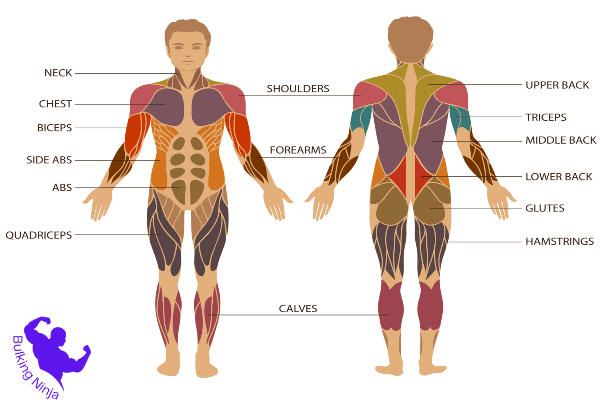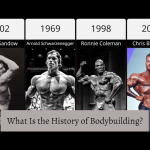The pursuit of a stronger, more muscular physique has long been a goal for fitness enthusiasts and athletes alike. And at the heart of this endeavor lies the age-old practice of strength training. But can you gain muscle from strength training alone? It’s a question that’s intrigued fitness novices and experts alike for generations.
In this blog post, we’re here to unravel the mysteries surrounding muscle growth through strength training. We’ll delve into the science behind it, explore the essential principles, and provide practical insights to help you understand just how effective strength training can be in sculpting your dream physique.
So, if you’ve ever wondered whether those hours at the gym are paying off in muscle gains, read on to uncover the truth about the transformative power of strength training.
Table of Contents
Can You Gain Muscle from Strength Training?

Strength training, an integral component of physical health, offers a variety of benefits. By consistently engaging in resistance training, individuals can build strength, challenge their bodies, and increase their physical function. This leads to improved health, reduced risk of injury, and the development of a more robust physique with well-defined muscles.
The external resistance, provided by weights and sets during exercises like the bench press, helps individuals lift heavier loads and manipulate variables to achieve better results over time.
Long-term consistency in resistance training can be linked to a decrease in mortality causes, offering a pathway to better overall health and the ability to perform better in various sports. It’s a practice that proves its worth, showing that you can indeed gain muscle from strength training while simultaneously enhancing your health and physique.
How long does it take to build strength?
Strength gains, a crucial aspect of this journey, often require long-term consistency and dedication to a well-structured training regimen. It’s worth noting that immediate strength gains can occur, particularly in untrained individuals, as the brain adapts to new training stimuli.
However, building substantial muscle size, a process known as muscle hypertrophy, typically takes time. This transformation is highly dependent on various factors, including nutrition, training intensity, frequency, and individual characteristics such as age and sex.
To achieve appreciable muscle hypertrophy, one should maintain focus on their goals and understand that it takes time, as a recent review suggests.
So, while the journey may vary from person to person, the path to gaining muscle through strength training is marked by progress, determination, and the realization that results are achievable with dedication and the right approach.
Does Strength Training Build Bigger Muscles?

Strength training can build bigger muscles, but it’s important to understand how and under what conditions this happens.
Strength training primarily focuses on increasing an individual’s ability to generate force or strength. However, one of the key outcomes of strength training is muscle hypertrophy, which is the scientific term for muscle growth. When you engage in strength training exercises, especially with progressive overload (gradually increasing the resistance or weight), you subject your muscles to stress and resistance beyond what they are accustomed to. This stress triggers a physiological response in the body to repair and adapt the muscles, resulting in an increase in muscle size and strength.
Here’s how strength training contributes to building bigger muscles:
Muscle Fiber Recruitment
During strength training, you recruit more muscle fibers, especially the fast-twitch muscle fibers responsible for explosive movements. This recruitment and activation of a larger number of muscle fibers lead to muscle growth.
Hypertrophy
Strength training can induce muscle hypertrophy, primarily when performed with sufficient intensity and volume. Muscle hypertrophy occurs when the individual muscle fibers increase in size, resulting in overall muscle growth.
Nutrition
Proper nutrition, including an adequate intake of protein, is essential for muscle growth. Strength training creates a demand for required protein synthesis, and providing the body with enough protein and nutrients supports muscle recovery and growth.
Recovery
Adequate rest and recovery between strength training sessions are crucial for muscle growth. Muscles need time to repair and grow, and overtraining can hinder this process.
Progressive Overload
Continuously challenging your muscles by increasing resistance or weight is a fundamental principle of strength training. Gradually adding more resistance forces the muscles to adapt and grow.
It’s important to note that while strength training can build bigger muscles, individual results may vary depending on factors such as genetics, training program, diet, and consistency. Moreover, some people may focus on strength training primarily for functional strength and not necessarily for maximizing muscle size. Therefore, the extent of muscle growth achieved through strength training can vary from person to person based on their goals and approach to training.
Goals for weight training
Weight training offers a plethora of advantages, going beyond just enhancing overall well-being. Among the objectives associated with weight training are elevated strength, the development of muscle mass, enhanced endurance, and increased power.
Strength
When embarking on the journey of gaining muscle through strength training, it’s crucial to consider individual factors such as age, training history, and motivation. Strength training, encompassing exercises like the bench press and squat, allows individuals to progressively adapt their bodies to lifting heavier loads, leading to noticeable progress.
To assess these gains, one can perform a 1 rep max (1RM) test, indicating the ability to lift increasing loads over time. Research has shown that strength gains are achievable with loads greater than 60% of your 1RM, and for those with prior training experience, loads exceeding 80% may yield even better results.
While muscle failure and sets play a role in the process, optimizing rest periods between sets can be beneficial from a time-saving standpoint. The key is to adjust training parameters to your ability and time allotment, with the ultimate goal of improving strength and achieving optimal muscle adaptation. These recommendations highlight the positive impact that strength training can have on both the body and one’s overall well-being.
Hypertrophy
In the realm of strength training, the pursuit of muscle hypertrophy, or an increase in muscle size, is a common goal. To achieve this, individuals may tailor their training program to focus on hypertrophy training, which involves a combination of sets, repetitions, and rest periods. It’s noteworthy that maximal lifting, while important for some aspects of strength development, may not always need to be the core of such a program.
Studies have observed that hypertrophy can occur effectively with loads as low as 30% of the 1 RM, emphasizing that the journey to increased muscle size doesn’t always require lifting maximal loads. The key factor remains training with high intensity until reaching muscular failure, as this approach promotes greater gains in muscle mass.
Additionally, rest between sets, typically ranging from 1 to 3 minutes, aligns with working towards both muscle growth and endurance. It’s interesting to note that some studies even postulate that longer rest periods between sets can further promote increases in muscle endurance.
Therefore, when considering the question of whether you can gain muscle from strength training, the evidence suggests that tailored hypertrophy training, coupled with the right intensity and rest periods, can indeed help you achieve your goal of increased muscle size.
Muscular endurance
In the realm of strength training, building muscular endurance plays a vital role. This ability involves efficiently moving submaximal loads while resisting muscle fatigue. Training to enhance muscular endurance typically revolves around using loads that are 40–60% of your 1 RM, allowing your muscles to improve their physiologic efficiency.
This increased efficiency enables you to perform repeated contractions without succumbing to fatigue. Functionally, this translates into the capacity to push your body for more extended periods, whether it’s during activities like jogging or swimming.
Such training typically involves performing 2–3 sets of 15 or more repetitions with shorter rest intervals, usually around 30–60 seconds. This approach not only improves your ability to move and resist fatigue but also contributes positively to your overall strength training journey.
Power
In the realm of strength training, the concept of muscle power is pivotal. Muscle power, which involves the ability to produce force and speed, plays a crucial role in various activities such as sprinting, discus-throwing, slam-ball exercises, and jumping. These dynamic movements require the ideal balance of force and speed, allowing individuals to respond effectively to the demands of their chosen activities.
When it comes to training for muscle power, it’s important to avoid pushing your muscles to failure. This type of training typically involves power movements like squats and explosive lifts such as the power clean, where loads are customized to enhance your performance. For instance, loads of 30–70% of your 1RM can be used to elicit the desired gains in muscle power. Repetitions in the range of 4–10, paired with longer rest periods for recovery, are often part of this type of training.
Additionally, contrast training, involving heavy resistance sets combined with speed-based movements, can help pre-fatigue muscles and enhance overall performance. So, through tailored strength training, you can harness your muscle power, improve your abilities, and excel in a variety of dynamic activities, showcasing the positive impact of strength training on your overall performance and physique.
Which Muscles Are Used In Strength Training?

Strength training engages a variety of muscles throughout the body. The specific muscles worked depend on the exercises and movements involved in a strength training routine. Here are some of the major muscle groups commonly targeted in strength training:
Leg Muscles
Quadriceps (front of the thighs)
The quadriceps are a group of four muscles located at the front of your thighs. They play a crucial role in knee extension and are heavily involved in activities like running, jumping, and squatting.
Hamstrings (back of the thighs)
The hamstrings are a group of muscles on the back of your thighs. They are responsible for bending the knee and extending the hip joint. These muscles are used in activities like walking, running, and cycling.
Glutes (buttocks)
The gluteal muscles, or glutes, are located in the buttocks. They are responsible for hip extension, abduction, and rotation. Strong glutes are essential for activities like walking, climbing, and maintaining posture.
Calves (calf muscles)
The calf muscles consist of the gastrocnemius and soleus muscles, located in the lower leg. They are essential for pointing your toes and pushing off the ground when walking or running.
Core Muscles
Rectus abdominis (front of the abdomen)
The rectus abdominis, often referred to as the “six-pack” muscle, runs down the front of your abdomen and is responsible for flexing the spine.
Obliques (side of the abdomen)
The oblique muscles are located on the sides of your abdomen and help with twisting and lateral flexion of the spine.
Transverse abdominis (deep core muscles)
The transverse abdominis is a deep muscle that stabilizes the spine and helps maintain core stability.
Erector spinae (lower back)
The erector spinae muscles run along the spine’s length and play a crucial role in extending and straightening the spine.
Chest Muscles
Pectoralis major (chest)
The pectoralis major muscles, commonly known as the pecs, are responsible for chest movements, such as pushing and hugging.
Pectoralis minor (upper chest)
The pectoralis minor is a smaller muscle located beneath the pectoralis major and assists in shoulder movement.
Back Muscles
Latissimus dorsi (lats)
The latissimus dorsi muscles are large muscles in the back that assist in activities like pulling, lifting, and extending the arms.
Trapezius (upper back)
The trapezius muscles are located in the upper back and are responsible for various shoulder and neck movements.
Rhomboids (between the shoulder blades)
The rhomboid muscles are situated between the shoulder blades and help with scapular retraction and stability.
Shoulder Muscles
Deltoids (shoulder)
The deltoid muscles give the shoulders their shape and are responsible for various arm movements, including raising the arm to the side or front.
Rotator cuff muscles (stabilize the shoulder joint)
The rotator cuff muscles help stabilize the shoulder joint and are crucial for arm mobility and rotation.
Arm Muscles
Biceps brachii (front of the upper arm)
The biceps brachii are responsible for flexing the elbow joint and are commonly known as the “biceps.”
Triceps brachii (back of the upper arm)
The triceps brachii muscles extend the elbow joint and are located on the back of the upper arm.
Forearm muscles (used in gripping and lifting)
Various muscles in the forearm are essential for gripping and manipulating objects.
Calf Muscles
Gastrocnemius (upper calf)
The gastrocnemius is a prominent muscle in the upper calf responsible for plantar flexion of the foot, like when you stand on your tiptoes.
Soleus (lower calf)
The soleus muscle, located beneath the gastrocnemius, also plays a role in plantar flexion and contributes to lower leg stability.
Hip Muscles
Hip flexors
These muscles are responsible for flexing the hip joint and lifting the leg upward.
Hip adductors
The hip adductors are involved in bringing the thigh toward the midline of the body.
Hip abductors
These muscles help move the thigh away from the midline of the body.
Muscles of the Upper Body
Brachialis (beneath the biceps)
The brachialis muscle assists the biceps in flexing the elbow joint.
Brachioradialis (forearm)
The brachioradialis muscle is responsible for forearm flexion and plays a role in various hand movements.
Serratus anterior (boxer’s muscle, helps with arm movement)
The serratus anterior muscles assist in the movement and stability of the shoulder blades.
Levator scapulae (neck and shoulder)
The levator scapulae muscles are involved in elevating and stabilizing the shoulder blades.
Muscles of the Neck
Sternocleidomastoid (side of the neck)
The sternocleidomastoid muscles allow for neck flexion, rotation, and lateral flexion.
Scalenes (assist in neck movement and breathing)
The scalene muscles aid in neck movement and also play a role in respiration by elevating the ribs during deep breathing.
These are the major muscle groups in the human body, each with its unique functions and roles in facilitating movement and stability.
Different exercises and variations target these muscle groups to varying degrees. For example, squats primarily work the legs, deadlifts engage the back and legs, and bench presses focus on the chest and triceps. A well-rounded strength training program typically includes exercises that target all major muscle groups to promote balanced muscle development and overall functional strength.
Frequently Asked Questions
How To Train For Strength, Not Size?
To train for strength, focus on lifting heavy weights with low repetitions (1-6 reps per set). Prioritize compound exercises like squats, deadlifts, and bench presses. Limit the overall volume of your workouts and avoid training to muscle failure. Allow for longer rest periods (2-5 minutes) between sets to maximize strength output. Track your progress, use progressive overload, and emphasize specific movements you want to get stronger in.
How To Improve Strength And Power?
To improve strength and power, incorporate exercises such as lifting weights, using resistance bands, performing heavy gardening tasks, climbing stairs, hill walking, cycling, dancing, and engaging in bodyweight exercises like push-ups, sit-ups, and squats into your fitness routine. These activities can help enhance your overall strength and power effectively.
Unexpected Benefits Of Weight Training?
The unexpected benefits of weight training include a boosted metabolism, improved bone density, enhanced mind-body connection, stronger joints, increased brain power, better heart health, elevated testosterone levels in men, and improved sleep quality. Weight training offers a range of advantages beyond just building muscle strength.
How To Increase Muscle Strength At Home?
To increase muscle strength at home, engage in muscle-strengthening activities such as lifting weights, using resistance bands, doing heavy gardening tasks, climbing stairs, hill walking, cycling, dancing, and performing bodyweight exercises like push-ups, sit-ups, and squats. These exercises can be done in the comfort of your home to build and strengthen your muscles.
How To Increase Body Strength And Stamina?
To increase body strength and stamina, incorporate various exercises and activities like bench press, cycling, jumping jacks, push-ups, stair climbing, swimming, and High-intensity Interval Training (HIIT) into your fitness routine. These workouts will help enhance both your strength and stamina levels efficiently.
How To Build Muscle Naturally?
To build muscle naturally, consume small servings of protein-rich foods before and after resistance training sessions to promote muscle growth. Keep in mind that an increase in food intake may lead to temporary bloating or gas. Also, be prepared for the possibility of gaining some body fat as it’s challenging to increase muscle mass without a slight increase in body fat.
How To Increase Strength In Body Naturally?
To increase strength in the body naturally, incorporate resistance exercises like lifting weights, using resistance bands, and doing bodyweight exercises such as push-ups, sit-ups, and squats. Additionally, engage in activities like heavy gardening, climbing stairs, hill walking, cycling, and dancing to build strength and improve overall fitness.
Conclusion
In conclusion, the answer to the question, “Can you gain muscle from strength training?” is a resounding yes. Strength training, whether it involves lifting weights, bodyweight exercises, or resistance training, is a highly effective way to build muscle and increase overall strength.
The science behind muscle hypertrophy and the countless success stories from individuals who have transformed their bodies through strength training leave no room for doubt.
However, it’s crucial to remember that consistency, proper form, and a balanced approach to nutrition and recovery are key factors in achieving your muscle gain goals. So, whether you’re a seasoned lifter or just starting on your strength training journey, the potential for muscle growth is within your grasp, and with dedication and effort, you can achieve remarkable results.














